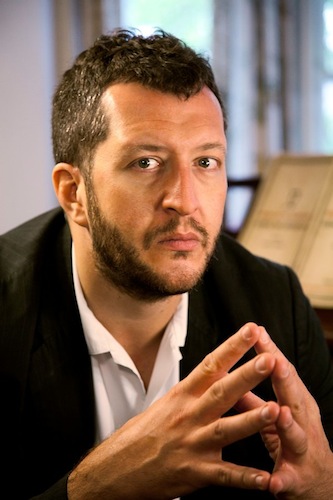Adés dances and romances death at Philharmonic
English composer Thomas Adés is making a highly anticipated visit to the New York Philharmonic this week, bringing not only his recent orchestral score, Totentanz, but his baton as well. Along with the American premiere of his music, he’s leading the orchestra in music from Beethoven and Berlioz. Opening night was Thursday.
Witnessing an active composer conduct is a chance to hear what should be strong and even idiosyncratic opinions on music in the classical repertoire. Adés’ ideas about Beethoven’s Symphony No. 1 and Berlioz’s Les Francs-juges Overture, inasmuch as they came through, reinforced the fundamental qualities of his own music.
He writes in the Late Romantic tradition—the harmonies, expression and weight of his music, and even the shifting rhythms and meters, come directly out of Strauss, late Mahler, even the early Stravinsky ballets. He hears Beethoven and Berlioz through what are now, paradoxically, the slightly archaic, mid–20th century values of size, loudness, and emotional poetry.
Totentanz is Adés most fully realized large-scale score to date. His music has always been consistently packed with inventive stretches. But a lack of clear, overarching organization, along with the density of his writing, has left the impression of a brilliant musical mind that is satisfied producing effects rather than a unified music that works from the first bar to the last.
Totentanz works musically, is fascinating and powerful throughout, though it’s language still is at one remove from touching the listener intimately. The piece makes clear what Adés is thinking, but while we hear what is in his head, we don’t necessarily feel it.
Or we feel something vivid that is different than intended. The piece is written around text from an early Renaissance danse macabre frieze made by Bernt Notke, and the words are full of irreverent humor, even quasi-scatological glee. Adés gives the poetry heavy, intense music that has no wit but plenty of force and is full of great sounds. Sung by mezzo-soprano Christianne Stotijn and baritone Mark Stone, death mows down Popes, Kings and Monks, one after another, showing no respect for their earthly importance.
The music has balance problems—it is scored for a large orchestra—and Stone was frequently swamped. The music is loud and furious, but Stotijn carried through it, a sign that the orchestration could be revisited.
Just as the constant density and fortissimo of the score threatens to exhaust the ear, the textures become more transparent and the music trades blunt force for seduction. Stotijn gets a gorgeous, downward swooping vocal line for the phrase “Death will swallow me,” and dance music finally begins. The last few minutes are a ravishing response to Das Lied von der Erde, the singers in a lyrical duet, repeating “tanz, tanz” over a slow, mildly intoxicated waltz, the orchestral textures imbued with that sour lushness that few other than Mahler himself can manage. The music travels down, down, through the lowest brass, the contrabassoon, the basses. The depths seem unimaginable.
Adés’ conducting was not on the same level as his composition. He has written some substantial stretches of music with challenging shifting meters, and he could not keep the orchestra together, with rhythms often a mess. The Philharmonic gave him their all, though, playing with tremendous verve, digging into ad lib sections with gusto, enjoying the experience.
Adés’ views on the past reinforced the quality of his own composing, and they came through his problematic conducting. In the opening Beethoven, Adés was most interested in the secondary themes, sequences and transitions. He also tried to modulate tempos for expression, but there were enough tiny fluctuations in his beat to make it difficult to discern what was the fundamental pace and what was the embellishment.
To his credit, he clearly inspired avid music making in the Philharmonic. Adés was exceedingly mannered with the slow introduction of Symphony No. 1, as well as the opening of the fourth movement. He never harnessed Beethoven’s essential rhythmic power in the Menuetto, and he was lost and left to follow the orchestra in the last few bars of the finale. The audience, perhaps primed by some favorable articles preceding the concert, applauded after every movement.
In Berlioz, the spirit was there, and the shape was willing, but the two never fully came together; the music’s juxtapositions sounded disjointed, rather than revealing the composer’s eccentric logic. Adés’ long, sweeping gestures were visually appealing but left the orchestra searching for the point of attack, though the musicians’ playing was good enough to take the lead.
Thomas Adés conducts the New York Philharmonic 7:30 p.m. Friday and 8 p.m. Saturday.
nyphil.org

Posted Mar 13, 2015 at 6:23 pm by Jane Martinez
I agree with much of what you said but wonder if the problem that you had with the baritone might have been caused by the hall’s odd acoustics. I sat near the stage in the front of the second tier, my preferred location, and never felt that the orchestra was overwhelming either singer.